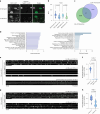An activity-regulated transcriptional program directly drives synaptogenesis
- PMID: 39103556
- PMCID: PMC11374667
- DOI: 10.1038/s41593-024-01728-x
An activity-regulated transcriptional program directly drives synaptogenesis
Erratum in
-
Author Correction: An activity-regulated transcriptional program directly drives synaptogenesis.Nat Neurosci. 2025 May;28(5):1108. doi: 10.1038/s41593-025-01950-1. Nat Neurosci. 2025. PMID: 40175692 Free PMC article. No abstract available.
Abstract
Although the molecular composition and architecture of synapses have been widely explored, much less is known about what genetic programs directly activate synaptic gene expression and how they are modulated. Here, using Caenorhabditis elegans dopaminergic neurons, we reveal that EGL-43/MECOM and FOS-1/FOS control an activity-dependent synaptogenesis program. Loss of either factor severely reduces presynaptic protein expression. Both factors bind directly to promoters of synaptic genes and act together with CUT homeobox transcription factors to activate transcription. egl-43 and fos-1 mutually promote each other's expression, and increasing the binding affinity of FOS-1 to the egl-43 locus results in increased presynaptic protein expression and synaptic function. EGL-43 regulates the expression of multiple transcription factors, including activity-regulated factors and developmental factors that define multiple aspects of dopaminergic identity. Together, we describe a robust genetic program underlying activity-regulated synapse formation during development.
© 2024. The Author(s).
Conflict of interest statement
The authors declare no competing interests.
Figures








References
-
- Deguchi, Y., Donato, F., Galimberti, I., Cabuy, E. & Caroni, P. Temporally matched subpopulations of selectively interconnected principal neurons in the hippocampus. Nat. Neurosci.14, 495–504 (2011). - PubMed
-
- Hobert, O. & Kratsios, P. Neuronal identity control by terminal selectors in worms, flies, and chordates. Curr. Opin. Neurobiol.56, 97–105 (2019). - PubMed
-
- Wiesel, T. N. & Hubel, D. H. Single-cell responses in striate cortex of kittens deprived of vision in one eye. J. Neurophysiol.26, 1003–1017 (1963). - PubMed
MeSH terms
Substances
Grants and funding
- F31 HD100091/HD/NICHD NIH HHS/United States
- LT000127/2016/Human Frontier Science Program (HFSP)
- U01 HG011952/HG/NHGRI NIH HHS/United States
- F31HD100091/U.S. Department of Health & Human Services | NIH | Eunice Kennedy Shriver National Institute of Child Health and Human Development (NICHD)
- R37NS048392/U.S. Department of Health & Human Services | NIH | National Institute of Neurological Disorders and Stroke (NINDS)
- R37 NS048392/NS/NINDS NIH HHS/United States
- F32NS129942/U.S. Department of Health & Human Services | NIH | National Institute of Neurological Disorders and Stroke (NINDS)
- U24 HG009293/HG/NHGRI NIH HHS/United States
- R01GM121597/U.S. Department of Health & Human Services | NIH | National Institute of General Medical Sciences (NIGMS)
- S10 OD018220/OD/NIH HHS/United States
- R01 GM121597/GM/NIGMS NIH HHS/United States
- F32 NS129942/NS/NINDS NIH HHS/United States
- P40 OD010440/OD/NIH HHS/United States
- Investigator/Howard Hughes Medical Institute (HHMI)
- U24HG009293/U.S. Department of Health & Human Services | NIH | National Human Genome Research Institute (NHGRI)
LinkOut - more resources
Full Text Sources
Molecular Biology Databases
Research Materials

